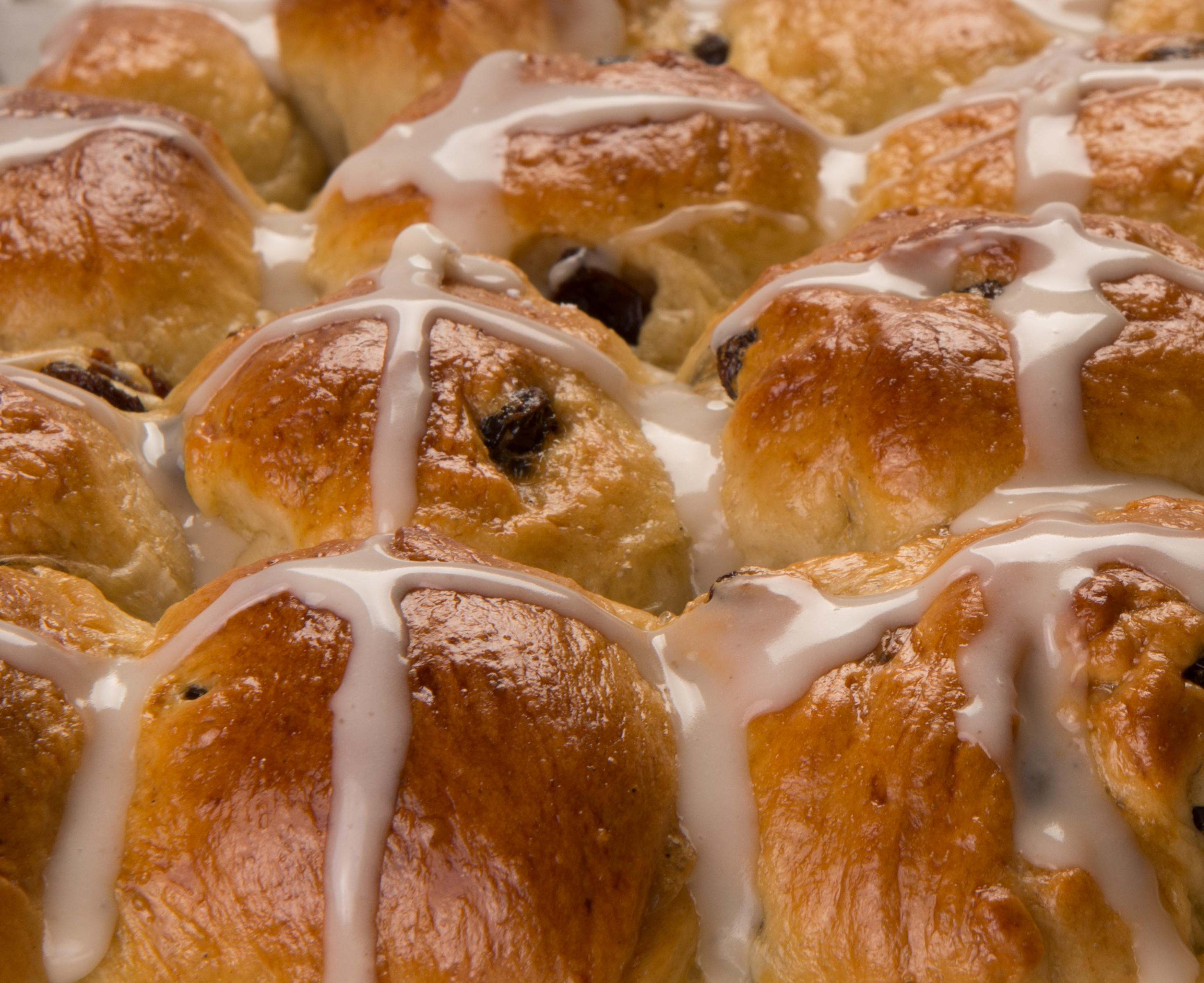Happy spring!
Who doesn’t love warm-from-the-oven rolls on a pretty spring day? Make them hot cross buns warm from the oven and slathered with cardamom-scented frosting and you are sure to swoon.
Some food historians tell us that the first hot cross buns were probably baked during the Middle Ages when a 12th century monk marked the sign of the cross on buns that he distributed as symbolic treats to celebrate Good Friday. Over time, it has become a tradition in many Christian communities to enjoy the delicious buns each year on Good Friday. Other historians suggest that the origin of the cross-marked yeasted sweet bread was far earlier, dating back to Roman times when a distinctive cross was carved into the surface of the bun to both facilitate the easy division of the bread into four parts and to pay homage to the four seasons. Buns marked with crosses were excavated at Herculaneum, an ancient city that was destroyed along with Pompeii by the eruption of Mount Vesuvius in A.D. 79.
The baking and consumption of hot cross buns has not been without controversy and superstition.
England’s 16th Century Renaissance Queen Elizabeth I endorsed a law to limit the sale of the sweet buns to funeral days, Christmas and Good Friday, believing that the pastries represented a Catholic challenge to the legitimacy of her Protestant reign. England, you will remember, had just gone through religious upheaval under Bloody Mary, Elizabeth’s predecessor and half-sister. Mary, married to Philip II, Spain’s dour Catholic king, had tried to restore Catholicism as the state religion in England and the couple hoped to undo the Protestant Reformation’s effects across Europe generally. In the process, a lot of people died. Understandably, Elizabeth was more than a wee bit edgy about possible religious intrigue in her court. Nevertheless, Elizabeth’s law was widely ignored. People clandestinely baked the buns in their homes and risked being busted for the culinary felony. (Some sources posit an alternative theory about Elizabeth’s hot cross bun law, arguing that Elizabeth, rather than having a religious motivation, supported the laws limiting consumption of the buns because she feared that her subjects would misuse the buns’ supposed supernatural powers. Frankly, this story sounds like a bit of clumsy revisionist history to me–16th century “fake news.” )
Other superstitions developed about the consumption of the buns. Many believed, for instance, that the baking of the buns protected sailors from shipwrecks. Others believed that hanging the buns from the rafters of one’s house warded off evil spirits and that baking the buns on Good Friday would confer qualities to the buns that would prevent them from molding and render them edible for a full year. Still others believed that the buns, when dried, had supernatural powers to heal wounds. Accordingly, old buns were dried and ground and sprinkled into wounds. (Ouch!) It was also thought that hanging a bun in one’s kitchen would protect that kitchen from fires and ensure a year of successful baking.
OK. Enough history.
This recipe is adapted from one that appears in a wonderful baking book titled The Hot Bread Kitchen by Jessamyn Waldman Rodriguez and the bakers of Hot Bread Kitchen. East Harlem’s Hot Bread Kitchen is distinguished both by the fact that it produces exceptional artisan-quality breads and by its business model. The bakery operates a six month baker training program for immigrant women that provides paid training while also helping the women hone key skills like English as a second language, bakery math, and science to make them more employable. Remarkably, Hot Bread Kitchen places 100% of their job-seeking graduates in full-time, fair wage positions. Here is a link to a great video about the bakery. At a time of so much negativity, it is reassuring to see a project that is successfully helping people who are new to America become self-sufficient: Hot Bread Kitchen Video on You Tube.
Here is a link to the Hot Bread Kitchen website: The Hot Bread Kitchen Website.
(You can buy The Hot Bread Kitchen cookbook here.)
Ingredients
- 1 t. active dry yeast
- 3/4 C. (180 grams) whole milk
- 3 C. plus 2 T. (405 grams) bread flour (plus more for shaping)
- 1/4 C. (50 grams) granulated sugar
- 1 t. kosher salt
- 1/2 t. ground cardamom
- 4 T. (60 grams) unsalted butter (at room temperature)
- 2 large eggs
- 1/2 C. (65 grams) raisins
- 1/2 C. (65 grams) dried currants
- Canola oil
- 1/2 C. (65 grams) powdered sugar
- 2-3 t. whole milk
- 1/2 t. vanilla extract
- Pinch of ground cardamom
Instructions
- Combine yeast and room temperature (or slightly warm) milk in the bowl of your stand mixer. Stir. Let the milk and yeast sit for a few minutes until it starts to get bubbly. (I sprinkled a bit of the sugar for this recipe over the yeast and milk to speed up the process.)
- Add bread flour, granulated sugar, salt, cardamom, butter and one egg to the yeast/milk mixture. Using the dough hook attachment on your stand mixer, mix the ingredients together.It should take about three minutes for the ingredients to thoroughly mix. If, at the end of three minutes, the dry ingredients haven't mixed well into the wet ingredients, you can add a small amount of water. Increase the speed of your mixer to medium-high and knead the dough for about four minutes to develop the gluten. Properly prepared, the dough will be shiny and will come away from the sides of the mixer when it is ready. You can also do the windowpane test to see if the dough is ready. This means that you take a small amount of dough and stretch it sideways between your fingers. The dough should not break when you stretch it. Instead, you should be able to hold the stretched dough up to a light and see the light through the thin dough--as you would see light through a windowpane.
- Add the raisins and currants to the dough and mix for one or two minutes to combine. I didn't have currants, so I used only raisins (1 cup) and the buns were great.
- Put your dough on a lightly-floured surface and gently knead it a couple times to get the raisins and currants fully incorporated into the dough. Put the dough in a large oiled bowl and cover loosely with plastic wrap. Set the bowl in a warm place in your kitchen or in your oven set on the proofing function and let it rise for about an hour. According to the original recipe, the dough should be "softer than a firm balloon," should be supple and should hold an indentation when pressed lightly with your finger.
- Use parchment paper to line a rimmed baking sheet (I used a quarter sheet pan.). Turn the dough out onto a lightly-floured surface. Divide the dough into twelve parts. Each part should weigh about 2 1/2 ounces or 75 grams. Form each piece into a small ball and place it, seam side down, on your prepared baking sheet. When you are through, you should have a grid of 3 x 4 dough balls and the dough balls should be touching. Cover the baking sheet loosely with plastic wrap and let it sit for another hour.
- Preheat your oven to 350 degrees F.
- Lightly beat the one egg that remains and brush the buns with the egg. Place into preheated oven and bake for 30 minutes. The rolls should be a pretty brown when they are done and should be firm to the touch. Remove from oven and cool on a wire rack.
- Prepare the icing by whisking all the ingredients together. Add the liquids to the powdered sugar until it has a good piping consistency. You don't want it to be too thin. Once the buns are cool, pipe the icing on the top of the rolls to make crosses on the rolls.



 Save Recipe
Save Recipe

6 thoughts on “One a penny, two a penny: Hot Cross Buns”